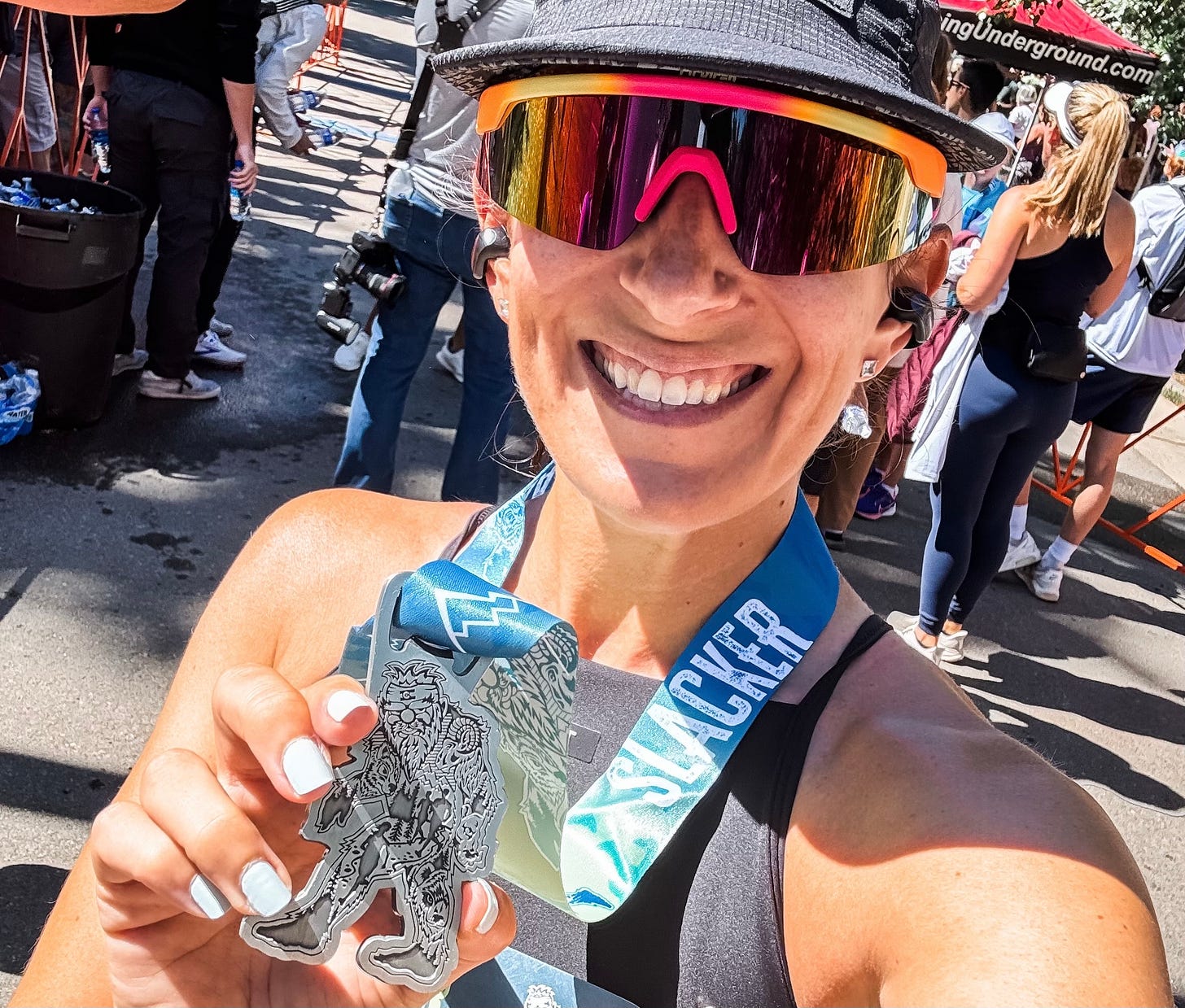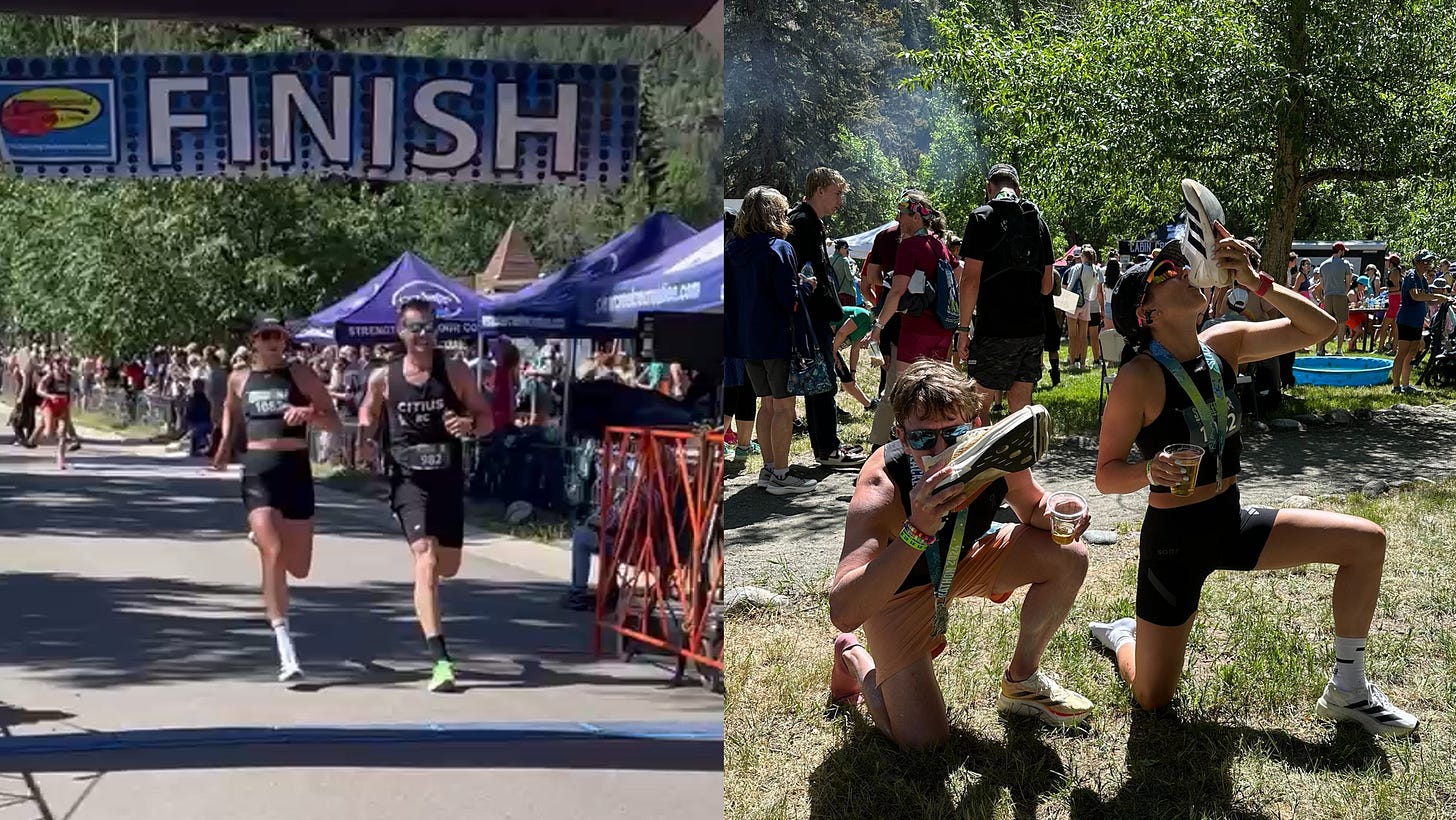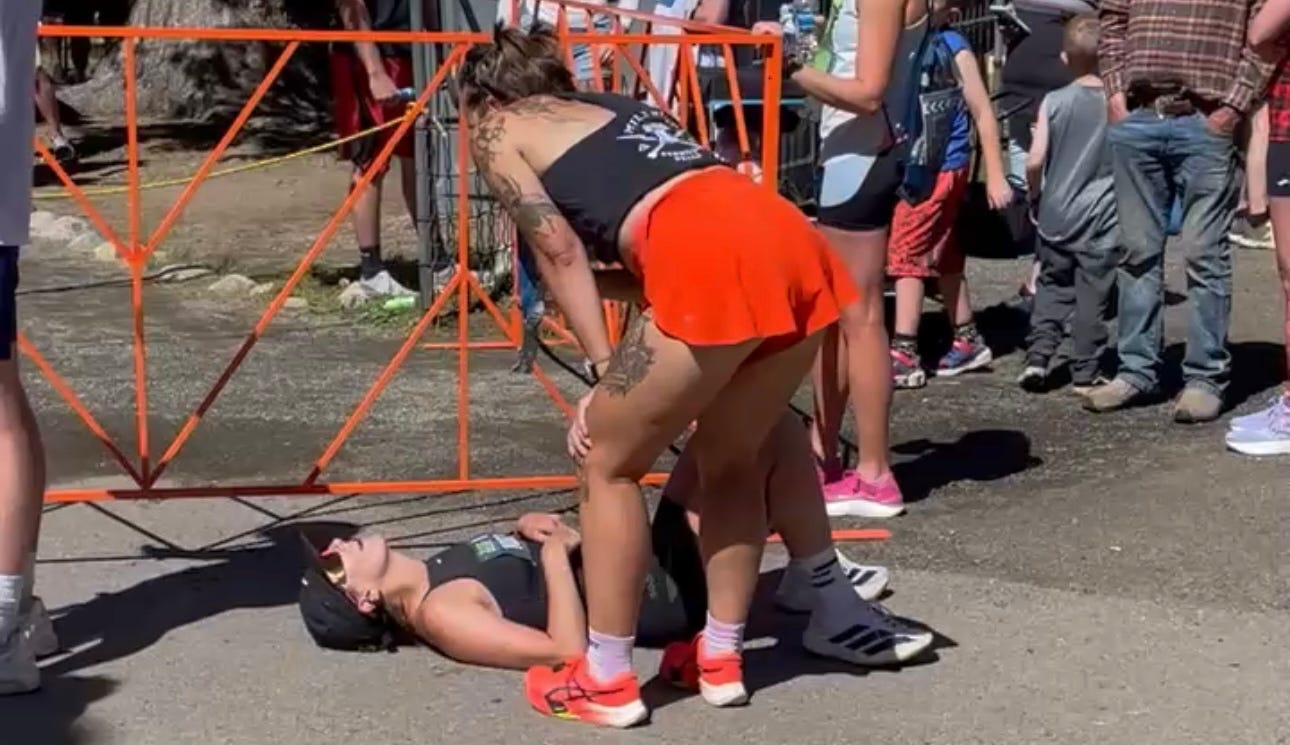Slacker Half Marathon Recap
What could be more fun than hurling yourself down a mountain for 13.1 miles?
Ah, the Slacker Half Marathon. I know I’ve said I’m not a fan of redemption races, BUT I have some baggage when it comes to this race.
Quick refresher on this race: It’s the highest half marathon in the country. Slacker starts at Loveland Ski Basin, nearly 11,000’ above sea level, and ends in Georgetown, CO, which is still around 8,400’ above sea level. The name is a joke, because even though the course is overwhelmingly downhill, there are some rollers in the middle—there’s somewhere between 100 and 150 feet of gain overall—that can be seriously challenging because of the elevation.
I ran Slacker for the first time in June 2021; I set my half marathon PR on the course, spectacularly blowing up my quads in the process. It was one of those races that left me hungry for more. There’s a unique challenge to besting a course with this much elevation loss, while also battling the complications that come with competing at high altitude. But I’ve gotten worse at Slacker every year since. In 2022, I ran it six weeks after the Colorado Marathon (also a downhill course, and my legs had not quite recovered), and in 2023, I ran with three weeks of antibiotics in my system (which we all learned was a terrible idea). This year, I meant business.
There’s a contingent of runners out there who will argue that downhill races are “cheating” or that your PRs don’t count on a downhill course. IMO, that’s absurd, especially if you’re not a pro or even coming close to a podium spot. And in the case of the Slacker Half, I think the elevation cancels out the benefits of the descent; if you aren’t prepared for it, this course will chew you up and spit you out (I know, because it’s destroyed me every time I didn’t train for it). This year, this was my goal half marathon and I trained specifically for the course profile. I did a lot of extended tempo work. I’ve been strength training three times a week for the better part of a year, with a serious focus on deadlifts and squats. I did a 10-mile downhill workout at around goal half marathon pace on a much steeper route. I was ready.
And it all paid off! I ended up running a two-minute PR.
But it was kind of a bittersweet PR, because I know I was fit enough to run significantly faster. The problem: My abs. Since the BAA 5K in April, I’ve been getting a cramp in my abdominals when I run faster paces (it also happened in the San Francisco Half Marathon last summer). It’s not hydration- or nutrition-related; it’s most likely something to do with my form. You know how it feels when a Charley horse in your calf wakes you up at night? Imagine that kind of spasm popping up mid-race. Heading into the race, I was super anxious about experiencing this kind of cramp again, and—FML—I could feel a knot forming in my upper abs around mile three.
I tried everything: I kept telling myself “nose over toes” and “ribs to hips” to keep my form in check, I was exhaling with force every time my right foot hit the ground to reset my diaphragm, I was massaging my abs (and literally hitting them at some points) to try and break up the spasm. In miles 6 and 7, it kept getting tighter and tighter, making it harder and harder for me to breathe—forcing me to slow my pace—until mile 8 when I had to walk to try and stretch the muscle enough to release it.
That did help; I was able to pick things back up to goal pace in mile 9, but from there, it was a sort of stop-and-go pacing strategy to the finish. When I was running, I was cruising—but the deeper I tried to breathe, the more it exacerbated that stabbing sensation that radiated upwards into my lungs. Because I couldn’t get my breathing under control, I’d end up having to take brief walk breaks before I could run again. I still managed a strong kick at the end (which almost made me vomit, how fun), and I had to lay down the second I crossed the finish line. Dramatic, yes, but that was so. painful.
I’m frustrated, because I know I’m capable of running faster than that, and I feel a little like my body betrayed me. That cramp cost me minutes, and it’s so obvious to see where it threw off my race plan when I look at my splits. I know, a PR is a PR—but I’m sure anyone who’s had a similar race derailed by a variable outside of their control can relate. It’s hard when you feel like a race doesn’t accurately reflect where your fitness is at, even if you’re still proud of the finish time.
That said, I did walk away from this race with a really important realization: I’m stronger and fitter than I’ve ever been. In the past, downhill races have destroyed my quads and calves, but this year my legs don’t even feel that fatigued. The last three times I’ve run Slacker, I’ve had to walk in the first mile to bring my heart rate back to a normal level due to the elevation; this time, I didn’t have to—and I didn’t feel like the altitude affected me that much overall. That strength carried over to my mental state, too. I’m proud of myself for not totally throwing in the towel when I realized this cramp wasn’t going away. Negative self-talk is my kryptonite, and even a year ago I would have let self-doubt ruin my entire race experience. This time, I was able to switch my thoughts to ones that served me better in the moment and did what I needed to do to feel like I was back in control, and I’m really proud of that.
It’s a really great feeling to see how the training I’ve been doing is paying off physically and mentally. I know there’s more in the tank, and I’m fired up to get to the bottom of what’s causing this cramping before fall marathon training starts!
the rundown
Adizero SL2
I’m a big fan of the speedier styles in Adidas’ Adizero line, but I don’t actually think I ever ran in the OG Adizero SL. The SL2 was kind of a surprise to me! It’s meant to combine the comfort of a daily trainer with the “trademark speed” of Adizero, and it does that with a full-length Lightstrike Pro insert (the same bouncy foam you’d find in the Adizero Prime X Strung and Adizero Adios Pro 3) packed into the Lightstrike 2.0 midsole. You’re getting lots of lightweight cushioning—that’s much softer than what you’d find in the Adizero Boston—with the kind of snappy responsiveness you’d get in a trainer like the ASICS Novablast 4. At $130, it’s also one of Adidas’ more affordable trainers, and I’m kind of into the all-black aesthetic after seeing so many prototype-white models lately.
Why Is Everyone On Steroids Now?
I was recently talking to my coach about this in the running space after Steve Magness posted a Tweet calling steroids “the new exercise influencer growth hack.” It’s a great story hook, and GQ beat me to it. This article delves into the use of performance-enhancing drugs by amateur athletes and regular dudes, fueled mostly—it seems—by social media comparison. It’s kind of wild to me how quickly people are willing to accept extreme measures as a shortcut to aesthetic outcomes, especially considering the risks (one subject in the story casually mentions going into septic shock after a self-administered dose), and it seems to have some parallels with the “running is therapy” crowd. One subject said, “a lot of men are attracted to trying to fix a hole in their ego,” and the author summed up my feelings perfectly: “I think this may be the saddest story I’ve ever done.”
Non-Profits Unite to Champion Female Athletes at USATF Olympic Trials
We love to hear it! Women’s running does feel like the more exciting part of the Trials this year, especially amidst this larger women’s sports moment, and this local news article details some of the non-profits that are supporting women in sports at the Trials, including Track Girlz, Bras for Girls, the Athletes Mental Health Foundation, and &Mother. There are also some interesting insights from the author of the new book The Price She Pays, which is next in my “must-read” pile. It’s cool to see an increased presence from non-profits like this, especially with more high-profile college athletes (Parker Valby, Katelyn Tuohy) competing this year.
Get Your Protein In Post-Workout—Eventually
You’ve probably heard how important it is to eat protein after lifting—but do you need to consume it within 30 minutes? An hour?! The timing doesn’t matter so much, according to a new study published in Frontiers in Nutrition. Over the course of eight weeks, male athletes completed four training sessions per week and consumed 25 grams of whey protein either immediately before and after exercise or three hours before and three hours after exercise. At the end of the study, there were no differences between the groups in terms of muscle mass and muscular performance (strength & power). The study authors did note that the timing of protein intake could have a different effect on endurance activities, but the most important takeaway is to get that protein in, even if it’s a few hours later!







